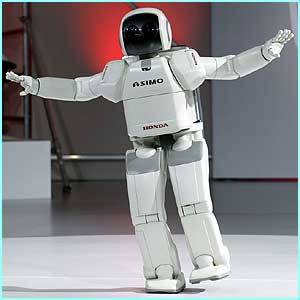Robotics
 From Conservapedia
From Conservapedia 
The word robot is simply the word for work in Slovak. It was coined by the author Karel Capek in a 1920 play, R. U. R. (Rossum's Universal Robots) and soon became popular in many languages.
Modern robots[edit]
Robots are a biomechanical or electro-mechanical device or a group of devices that perform an autonomous or programmed task. Robots can be used in a number of different tasks from working in places where humans cannot or where it is too dangerous for them. They can be used to help people with disabilities. For example, a person who has lost an arm might use a biomechanical arm. Robots also make a great educational tool from robotics competition to teaching mechanical engineering. Robots can perform tasks with greater precision than humans and are used in the making of automobiles and many other goods.
Fictional robots[edit]
Mechanical men existed in fiction before Capek. A Jewish folk tale published in 1847 tells of a "golem," a man made of clay who came to life. Various clockwork devices called automata mimicked animals or human beings, with simple repetitive motions, and it was easy to fantasize that someday someone might make one with more human-like ability.
Maelzel's chess player was a famous hoax. It was presented to audiences in the 1800s as a chess-playing machine, and it fooled many people. There was, literally, a man hidden inside the machine operating it.
Capek's R. U. R. concerned mechanical devices that looked like human beings, could think, and perform factory work. The word robot and the idea of human-like devices quickly became a staple of science-fiction. Science-fiction writers soon drew a distinction between "androids," which were supposed to duplicate the appearance of humans so closely that they could be mistaken for humans, and "robots," which did not. (Lucas blurred this distinction by calling the robots in Star Wars "droids," short for androids).
Isaac Asimov wrote a famous series of science fiction novels and stories about robots. Asimov was tired of innumerable stories that all used the same tired plot of robots rebelling and killing human beings. He decided to rule out this plot in his own stories by creating a fictional world in which robots had to obey the "three laws of robotics:"
- A robot may not injure a human being or, through inaction, allow a human being to come to harm.
- A robot must obey orders given it by human beings except where such orders would conflict with the First Law.
- A robot must protect its own existence as long as such protection does not conflict with the First or Second Law.
In his stories, robots are typically faced with moral dilemmas involving conflicts between the three laws, or questions about what constitutes "harm" to a human being. Sometimes the plot revolves around a robot that appears to be violating one of the Three Laws, until someone solves a mystery which explains why the robot is behaving as it does.
Links[edit]
- www.usfirst.org
- http://asimo.honda.com
Categories: [Robotics]
↧ Download as ZWI file | Last modified: 03/06/2023 02:01:06 | 70 views
☰ Source: https://www.conservapedia.com/Robotics | License: CC BY-SA 3.0
 ZWI signed:
ZWI signed: KSF
KSF